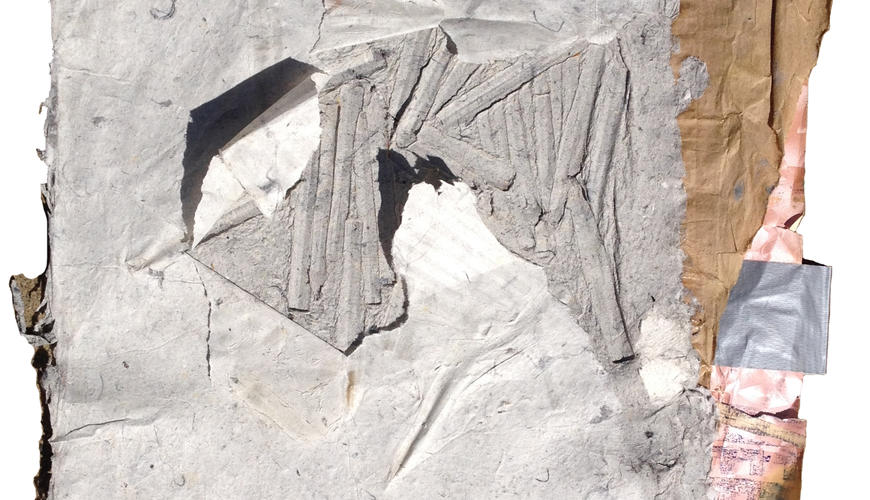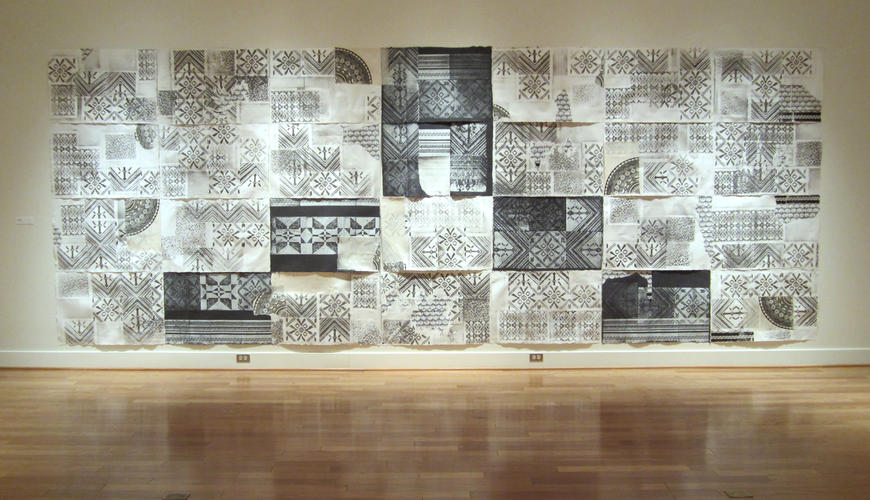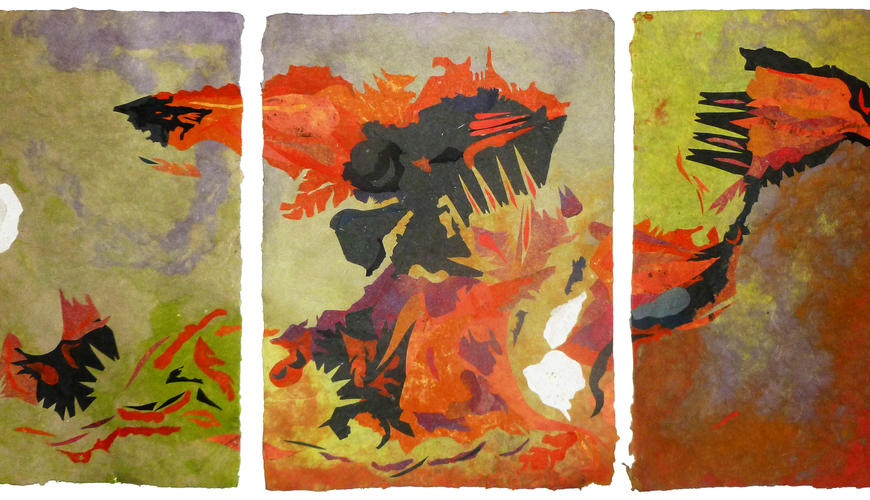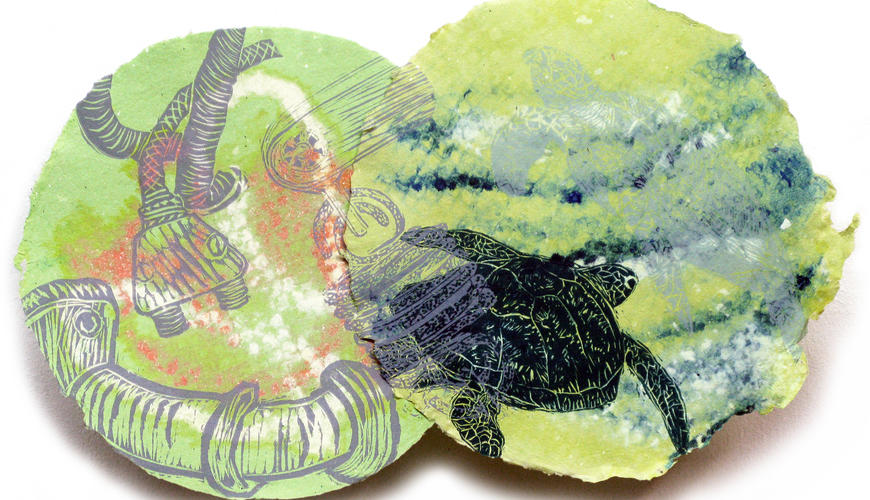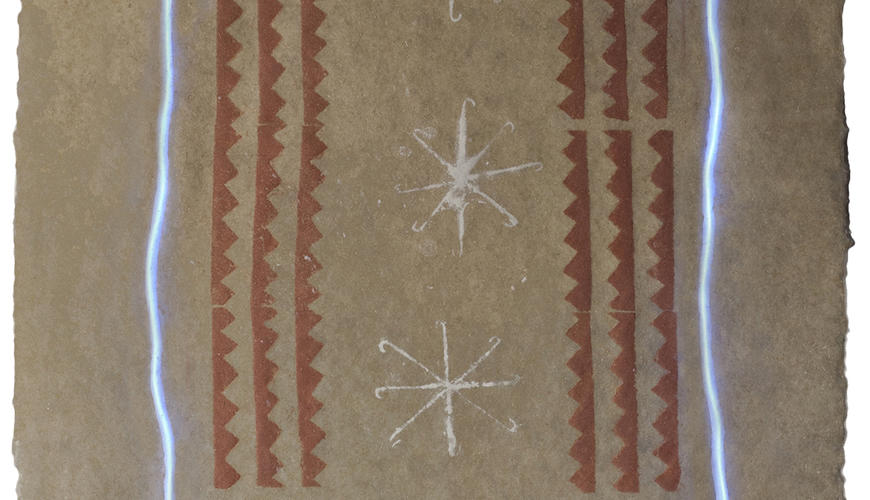
On View: January 10 through February 20, 2019
Reception: Wednesday, January 16, 4:30-6 p.m.
Artist Lecture with Reni Gower directly preceding reception:
Wednesday, January 16, 3:30 p.m. in the gallery.
Curatorial Essay / pulped Under Pressure
By Reni Gower and Melissa Potter
With traditional hand papermaking at its core, Pulped Under Pressure underscores important contemporary issues steeped in history and craft. Enticed through touch, these works encourage a contemplative slowing down even as they urge acknowledgement of some of the most pressing issues (environmental crisis to global marginalization) facing civilization today.
Each of the artists, Jillian Bruschera, Julia Goodman, Reni Gower, Trisha Martin, Melissa Potter, Marilyn Propp, and Maggie Puckett, starts simply with a foundation of pulp made from natural fibers. Their multifaceted results incorporate a rich range of printmaking, letterpress, papercutting, and installation.
Handmade paper is at the core of Jillian Bruschera’s interdisciplinary practice. It has become a primary material for installation, performance, collage, painting, writing, spoken-word, book-making, and letterpress printing. As such, the artist often recycles disposable materials by pulping and casting abandoned waste materials (junk mail, egg cartons, old cotton t-shirts, and ripped denim jeans) into new forms. By so doing, she conscientiously repurposes discarded resources. Poignantly, her paper bricks serve multiple functions that range from on-the-spot pulp material for pop-up papermaking workshops, kindling for campsite fires when she is on the road, or as a site specific art installation. Through her mobile papermaking mill, The Mobile Mill, the artist gives her audience an opportunity to use creativity as a source of empowerment that challenges authorship, ownership, and the preciousness of the art object made for market. For her, it is a way to communicate, collaborate, and celebrate the making of something by hand.
Gathering her own materials, Julia Goodman’s work reflects a resource-driven tradition. At a young age, she became acutely aware of mortality and the reality of scarcity. For her, that experience resonated with the history of papermaking and fueled her interest in working with imperfect materials that are simultaneously fragile and strong. In some of her recent work, she recycles old bedsheets into handmade paper and laminates beets into papyrus. By making paper, she crafts a material that carries an intimate history while also considering absorption, density, and mark-making. Many of her pieces invite an upward glance with references to wind or phases of the moon. Conversely working with the beetroot, she encourages the viewer to look down. Using the bold colors and diverse symmetries that exist underground, the artist creates intensely colored abstractions that transform this dense and humble material into exquisite uplifting works.
By incorporating sacred geometry, Reni Gower’s works reveal cross-cultural connections. Since ancient times, geometric perfection (circle, square, and triangle) has been thought to convey sacred and universal truths by reflecting the fractal interconnections of the natural world. One finds these similarities across cultures embedded in many diverse ethnic patterns. Incorporating these patterns into works of art promotes access through recognition. This commonality creates connections that encourage understanding. In these works, the patterns are based upon Celtic knotwork designs and Islamic tile motifs. For the papercuts, the patterns are traced and hand cut into interlocking motifs and the paper is painted on the back to reflect color back through the pristine white surface of the front. In the pulp paintings, the same stencils are used to block the sprayed pulp on the hand pulled paper ground. Using only a snap blade or a spray bottle, the artist celebrates the redemptive nuance of slow work made by hand and creates pristine works that counter visual skimming.
Keeping in mind that the world is quickly deteriorating place, Trisha Oralie Martin challenges her audience to look outside of themselves and to act as a community that can learn from one another. This holistic world view stems from her Filipina heritage and the philosophy that all human kind, in tandem with the visible and invisible world, are one. The artist envisions her art as a creative catalyst that can convey important social issues across diverse communities. Inspired by her cultural heritage, her highly patterned works are pulped and printed with native Filipino designs.
As a collaborative initiative, Seeds InService (SIS) explores the fertile intersection of the art of hand papermaking with gardening, social practice, community engagement, and creative pedagogy as well as individual artistic practice. The artists, Melissa Potter and Maggie Puckett combine hand papermaking projects with heirloom plants sourced from the Hull House Heirloom Seed Library and grown in The Papermaker’s Garden at Columbia College Chicago. These homegrown papermaking plant fibers are pulped, pulled, and pressed into new seed packets, which are printed with fragments of feminist literature. Ultimately the packets are dispersed with new heirloom seeds and care instructions through an ad-hoc distribution center. In essence, the Seeds InService (SIS) garden cultivates future generations of eco-gardeners and artist activists. Their collaborative pieces combine hand papermaking with letterpress printing.
Craft Power: Tusheti Rugs is a series of flax handmade paper laminated el wires that illuminate when plugged in. Through a collaborative research project called Handmade Media, Melissa Potter and Paul Catanese explored the intersection of hand crafted media with handmade paper. Melissa’s pieces were inspired by the crafts symbol system in the Republic of Georgia, where it is understood some of the images may be derived from ancient Amazonian cults celebrating female power.
Maggie Puckett also makes hybrid works by combining handmade paper, artist’s books, and printmaking techniques with social and environmental activism. In her piece, Pyche-Anthropocene Projection, Puckett uses the seductive tactility of handmade paper in concert with rich organic color to project the dire effects of climate change that she and others pessimistically predict in our future. Likewise, in the Big Here series, the audience is invited to participate by drawing and writing their responses to questions posed by the artist about the local environment. Puckett later transforms these handmade paper sheets into the pages of sculptural books. Through these types of informed interactions, Puckett hopes to trigger greater awareness about environmental issues that will in turn prompt socially engaged actions that start at the local, but impact the global.
In Notes from the Sea, industrial debris, machine parts, and marine life are entangled or morph into one another. This work is fueled by Marilyn Propp’s concerns about destructive environmental practices that destroy coral reefs, create floating islands of plastic, or spawn oil spills. She combines the materiality of handmade paper and printmaking with a luminous color palette to offer images of beauty that address this destruction.
As an ancient symbol of creativity, longevity, endurance, and persistence, the sea turtle is a sublime emblem. Given their ability to travel great distances and adapt to obstacles generated by climate change, exploitation, and habitat loss they are an ideal contemporary metaphor as well. In this series, the medium of handmade paper reflects both the undersea world and the way paper itself is made. As a watery material, the wet pulp is stirred, formed, drained and pressed. To create simplified marks that suggest the movement of sea forms, the artists drags her gloved stained fingers through the water. Likewise, pigmented pulp is pushed through a grid to fashion a textured surface similar to fish scales or cellular plant forms. When the paper is dry, the artist prints fragmented images of sea life and industrial debris. Using linoleum and wood blocks, she combines the texture and color of the paper with the crispness and layering of relief printing. To enhance the impression of an underwater glimpse, the prints are installed floating 3” off the wall. With their irregular deckles, the works evoke the movement of sea life and suggest filtered sunlight as though looking up through the water from below.
In very unique ways, these artists consider paper beyond its most common function as a passive surface of record. Instead, the material is transformed and imbedded with content that turns communication into a public practice. By challenging assumptions, the artists of Pulped Under Pressure create artworks that are both beautiful and brave.
